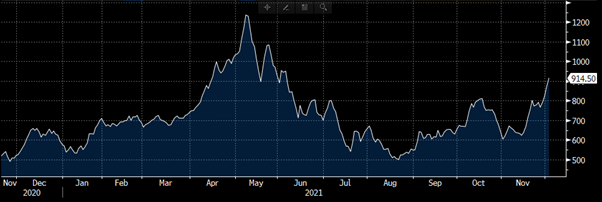Commodities are raw or partly refined materials, traded for processing into final goods. There is a broad range of commodities, and they’re split into groups.
Precious metals
Such as Gold, silver, platinum, palladium.
Base metals
Copper, aluminium, lead, zinc, nickel, tin, etc.
Energy
Crude oil, natural gas, heating oil, coal, electricity, etc.
Grains
Corn, oats, rice, wheat, etc.
Oil & meal
Soybeans, soy meal, cotton, canola, palm oil, etc.
Livestock
Pork, beef, etc.
Foodstuffs
Cocoa, coffee, orange juice, sugar, milk, etc.
Lumber
Particularly volatile prices in 2021.
Carbon emissions
A particularly topical commodity with the aggressive move towards a more environmentally friendly global economy.
Rare earths
Another particularly topical commodity because of their presence in electric vehicle battery production. Examples are cobalt, lithium, scandium, neodymium, gadolinium & ytterbium amongst others.
There are two ways to trade commodities: physical and derivatives.
Physical trading, as the name suggests, is where the producers, refiners and end users buy and sell the physical commodity. Producers include B.P. Shell, Glencore and Rio Tinto. End users include coal fired power stations, airlines, shipping companies, car companies and construction companies.
There are also commodity trading companies that specialize in the complex collection and delivery of the products from remote and barely accessible mines around the world, companies like Vale and Noble group.
Related article: Trading and Investing: A Beginner's GuideDerivative contracts (forwards, futures, options, swaps) were created so that these companies supplying, refining, and demanding commodities could hedge their future cash flows, as their profitability had whipsawed along with commodity prices which are much more volatile than other asset classes such as equities, bonds and FX.
Forty seven per cent of all commodity derivatives are oil trades and now, somewhat surprisingly, 93% of all oil derivative trades are by speculators such as hedge funds, asset managers and retail traders.

Lumber prices have been particularly volatile in 2021. (Source: Bloomberg)
Of course, demand and supply is a key driver of commodity prices.
With China’s surge in industrial production and construction over the last 25 years the country has been a huge source of demand for industrial commodities, typically taking 72% of global metallurgical coal supply, 50% of thermal coal, 48% of aluminium production and 47% of nickel production as an example.
However, if the Chinese economy slows, as we are seeing currently, then demand for these commodities falls, so commodity cycles are obviously highly correlated with global GDP.
The dollar can also have a significant impact on commodity demand because all commodities (except palm oil) are priced in U.S. dollars.
So, a higher dollar dampens demand as prices rise for non-dollar denominated currencies.
Related article: Forex Trading 101 - What You Need to KnowAs many commodities are mined in remote and emerging countries, the prices can be affected by local war and government restrictions.
The whole supply chain is also vulnerable due to geographical limitations, weather, and as we have found out recently, COVID-19 restrictions with mines and ports forced into lockdowns.
Commodities, especially gold, are also seen as an alternative investment in asset portfolios. Gold is also historically seen as a good hedge against inflation, but this trade has failed in 2021 as gold has not risen with the recent surge in inflation prints.
The oil price can also be influenced by hurricanes in the U.S. and Gulf of Mexico (production), terrorist events, and OPEC meetings.

Commodity forward prices are usually higher than the current spot price. This reflects the cost of storage and the cost of borrowing.
This upward slopping curve is known as contango. However, occasionally the spot price surges higher when there is a lack of supply due to drought or supply chain breakdowns.
Related article: Everything You Need to Know About ETF Trading
As the spot price surges, forward prices are lower reflating the expectations that supply will rise in the futures. This downward sloping curve is knows as backwardation, as the commodity supplies that hold stock have the strong hand.
Commodities markets (excluding oil) are typically far less liquid than other asset markets so prices can more volatile.
Supply chain breakdowns due to covid have also strangled supply and increased price volatility in 2020 and 2021.
Certain players also have the ability to manipulate markets, as we have seen physical trading houses deliberately influence warehouse inventories, and OPEC members work together to ‘stabilise’ prices (at higher levels!).
Key commodity trades in Q4 2021 are around electricity and natural gas prices with demand far out stripping supply as northern Europe enters winter heating season.
Another popular trade of course has been the surge in rare earths prices, the key component in electric vehicle battery production. On current estimates there’s clearly not enough of these rare earths to meet future production plans.




